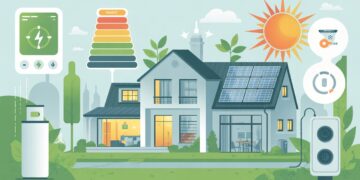Saving energy at home isn’t just about lowering your electricity bill, it’s also about reducing your carbon footprint and creating a more sustainable lifestyle. The good news? You don’t need to overhaul your entire house to see results. By making small changes in each room, you can significantly cut down your energy use and contribute to a greener planet.
This guide provides energy-saving tips for every room in your house, helping you identify practical ways to reduce home energy bills without sacrificing comfort.
Table of Contents
ToggleWhy Energy Conservation Matters
Whether you’re looking to be more eco-conscious or simply trying to lower your monthly expenses, adopting energy-saving habits makes a meaningful impact. According to the U.S. Department of Energy, the average household spends over $2,000 a year on energy. With smarter habits and some home upgrades, a significant portion of that cost can be saved.
Ready to start? Let’s explore room-by-room energy savings that are easy to implement and budget-friendly.
Living Room: Cut the Waste in Comfort
The living room is one of the most used areas of a home, especially during evenings and weekends. Here’s how to make it more energy-efficient:
Use LED Lighting
Switch out incandescent or CFL bulbs for LEDs. They use up to 80% less energy and last significantly longer.
Unplug Devices When Not in Use
TVs, game consoles, and streaming devices draw power even when turned off. Use smart power strips to eliminate phantom energy drain.
Manage Temperature Wisely
Close curtains during hot summer days to block heat and open them in winter to let sunlight warm the room naturally. Use ceiling fans to circulate air efficiently.
Kitchen: Optimize the Heart of the Home
Kitchens are full of energy-hungry appliances, but with a few adjustments, you can make your cooking space much more efficient.
Use Energy-Efficient Appliances
If you’re upgrading, choose ENERGY STAR-rated refrigerators, dishwashers, and ovens. They use less power and water without compromising performance.
Keep the Fridge Full (but Not Too Full)
A well-stocked fridge maintains its temperature more efficiently than an empty one. However, don’t overcrowd it—proper airflow is essential for cooling.
Cook Smart
Match your pots and pans to the right burner size. Use lids when boiling water to speed up the process. Microwaves and toaster ovens use less energy than conventional ovens for small meals.
Run Full Loads in the Dishwasher
Only run the dishwasher when it’s full, and let dishes air-dry instead of using the heat cycle.
Bathroom: Save Water and Energy Together
Bathrooms are often overlooked in energy-saving efforts, but they’re prime areas for improvement.
Install Low-Flow Fixtures
Low-flow showerheads and faucets can dramatically reduce water usage without sacrificing water pressure.
Lower the Water Heater Temperature
Setting your water heater to 120°F is sufficient for daily use and reduces energy consumption.
Use Exhaust Fans Wisely
Run the fan during and just after showers to control moisture, but turn it off after 15–20 minutes to avoid wasting electricity.
Swap Out Bulbs
As with other rooms, use LED lights to save electricity at home, especially in vanity lighting and overhead fixtures.
Bedroom: Rest Easy While Saving Energy
You spend nearly a third of your life in your bedroom make it an energy-efficient haven.
Program Your Thermostat
Use a smart thermostat to adjust temperatures based on your sleep schedule. Lower temps at night can also improve sleep quality and save energy.
Insulate Windows
Blackout curtains or thermal window treatments can reduce heat loss in winter and keep rooms cooler in summer.
Reduce Standby Power
Unplug chargers, lamps, and electronics when not in use, or connect them to a power strip with an on/off switch.
Keep It Dark
Night lights should be energy-efficient LEDs, and consider motion sensors to prevent unnecessary lighting.
Laundry Room: Clean Clothes, Lower Costs
The laundry room is another major energy consumer, especially if you’re using older appliances.
Wash in Cold Water
About 90% of the energy used by a washing machine goes to heating water. Cold water is sufficient for most loads.
Upgrade to High-Efficiency Machines
High-efficiency washers and dryers use less water and electricity. Look for ENERGY STAR models when replacing old units.
Air-Dry When Possible
Drying racks and clotheslines are great for delicate items and warm weather. You’ll also extend the life of your clothes.
Clean the Lint Filter
Always clean the dryer lint trap before every load to improve efficiency and reduce fire risk.
Garage and Basement: Don’t Overlook These Spaces
These utility areas often waste energy due to poor insulation and outdated lighting.
Improve Insulation
Seal gaps around doors and windows. Insulate water heaters and exposed pipes to maintain consistent temperatures and reduce heating costs.
Use LED Shop Lights
Replace fluorescent tubes or incandescent bulbs with LED strip lights for better illumination and energy savings.
Unplug Tools and Appliances
Power tools, mini-fridges, and other equipment can draw power even when idle. Unplug them when not in use or use a smart plug.
Whole-House Energy-Saving Tips
Some energy-saving strategies apply to the entire home and can multiply your savings when used together.
Smart Home Technology
Smart thermostats, lighting systems, and energy monitors help automate your efficiency and track your usage in real-time.
Maintain HVAC Systems
Replace filters every 1–3 months and schedule annual maintenance to ensure your heating and cooling systems are running efficiently.
Upgrade Insulation
Proper insulation in walls, attics, and crawlspaces reduces the need for constant heating and cooling.
Seasonal Adjustments
In summer, use fans and keep blinds closed. In winter, open curtains to let in heat and seal drafts to retain warmth.
Final Thoughts
There’s no need to tackle everything at once. The best approach to room-by-room energy savings is to start small and build momentum. Begin with one room maybe the kitchen or bedroom and implement just a few of the tips outlined above. Over time, these changes will add up to significant savings on your energy bill and a lower impact on the environment.









